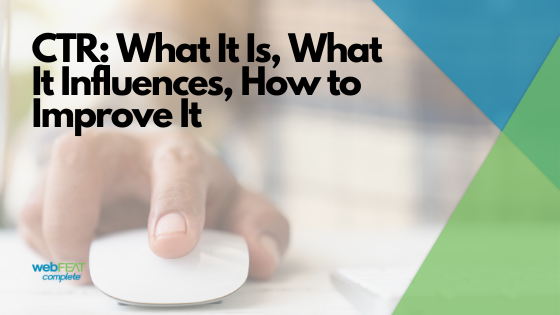What Is CTR?
CTR stands for Click Through Rate. It literally is the rate at which searchers click through to your website.
Clicks: clicks from search to your website.
Impressions: appearances in search.
Clicks/Impressions=CTR
It’s a metric that measures how well your ad or search listing is resonating with users, for Google’s algorithm. Wanting to serve relevant results to searchers, you can imagine why Google would prioritize the importance of this metric within its algorithm, and therefore why you should too.
What Does CTR Influence?
SEO: Rankings
PPC: Ad Position + Cost
Making it extremely important for digital marketers to be monitoring, and working to improve this metric.
Here are some examples of the close correlation CTR can have with rankings:
*Teal: CTR, Orange: Average Position


You can see in the first graph, that CTR was low, and rankings were suffering because of it. When CTR bounced back up—so did rankings.
In the second graph, Click through rate has been steadily growing, and with it, rankings. Starting now, and into April—I would expect continued improvement of average position as a result of that recent spike in CTR.
How to Improve CTR
For SEO
- Update meta information (based on research) to differentiate pages, and help searchers understand what is on the page
- Review low CTR, high impression phrases in Google Search Console to make a dramatic impact, quickly
- Review pages with similar content, to eliminate internal competition
- Build high-quality content
- Update past content regularly, and continuously improve past content/posts
Let’s discuss 2 examples.
Internal Competition
With all of the discussion out there about content, it makes sense that businesses want to create as much content as possible. However, if that content isn’t being managed, it can get out of control. You can end up having 4 or 5 pages targeting the same search phrase.
Similar content is a problem for search engine bots. It makes it unclear which page they should prioritize, and that internal competition results in much lower chances of ranking well.
By reviewing Search Console data that is filtered for specific topics or search phrases, you can identify internal competition and eliminate it. This can be done by making pages and posts more specific to a particular ranking target, or taking down a page and redirecting it to the most valuable, searcher friendly page for that target.
Consistently Created + Updated Quality Content
Perhaps you’re starting from scratch, not ranking for much. You know you need to get content out there, so you start writing a lot of high quality, targeted blog posts.
Because the content is great, Google gives it some exposure, and from time to time the content will also generate quality traffic.
That being said, it’s natural that impressions will outpace clicks, driving CTR down. It’s not necessarily a bad thing in this case, because Google also takes into account engagement metrics that positively influence rankings. Engagement metrics like average time on page will improve with great content.
Also, over time Google will better understand what to rank you for, naturally weeding out some irrelevant phrases, and giving your CTR a slight boost.

*Teal=CTR, Purple=Impressions
For Digital Ads
- Update headlines (based on research)
- Update descriptions (based on research)
- Pause bidding on low CTR keywords
- Pause/Recreate ads entirely to be more relevant to keywords
- Utilize/Add extensions
- Implement positive bid adjustments where CTR is high (locations, devices, ad schedule, etc.)
- Disclaimer—other metrics need to be taken into consideration with all of these account changes. I would rather put a bid adjustment on mobile devices seeing all conversions, as opposed to bid adjusting tablets who has no conversions, and a high CTR.
Targeting Lacks Research
Research is so important.
When we inherit accounts, we sadly see from time to time that accounts are built out with poor keyword targets. Sometimes phrases are too general, therefore making the space competitive and expensive with ads that don’t resonate to users directly.
If you are a shoe store selling Nike’s and you just target “mens shoes” you’re entering competition with dress shoes, flip flops, more that are likely irrelevant to your search. Adjusting to target “mens nike running shoes” would help you have a target that is more likely to make a purchase, and less costly to capture.
Any decision on targeting should be backed by research.
Who is monitoring your company’s CTR and trying to improve it?
For the digital marketers out there, leave us a comment if you have any questions!
If you’re a business that would like to have me and the SEO Department here at webFEAT Complete improve your CTR for better rankings + digital advertising results—contact us!
CTR requires regular attention, which is part of why we always advise ongoing work.
We’d love to discuss your online situation.
“”

